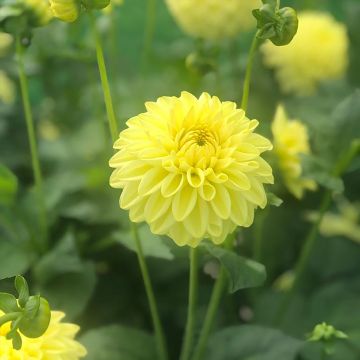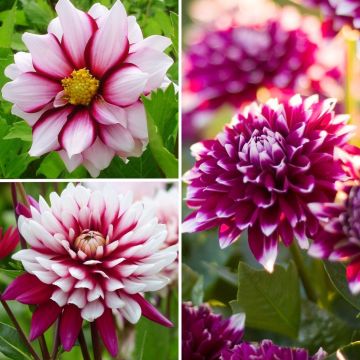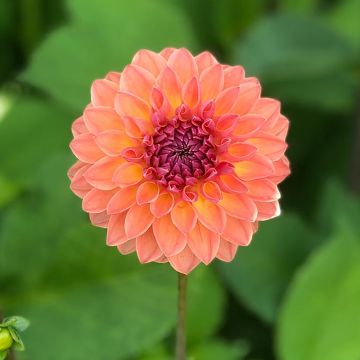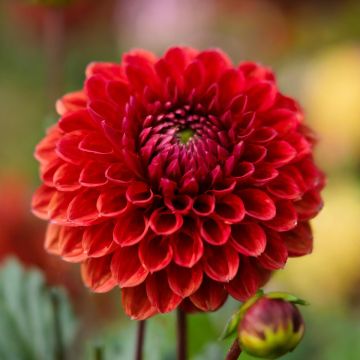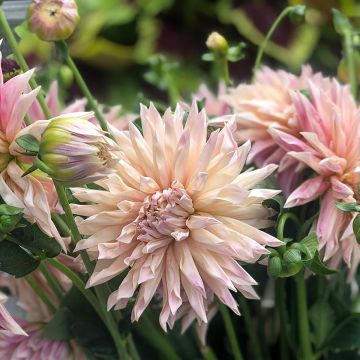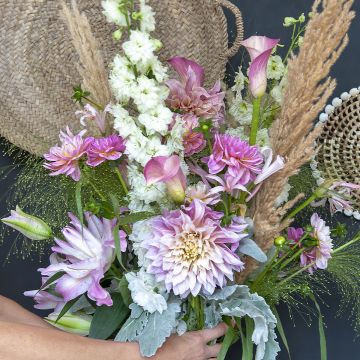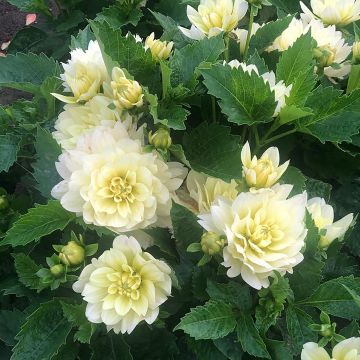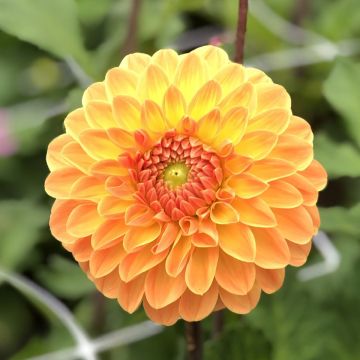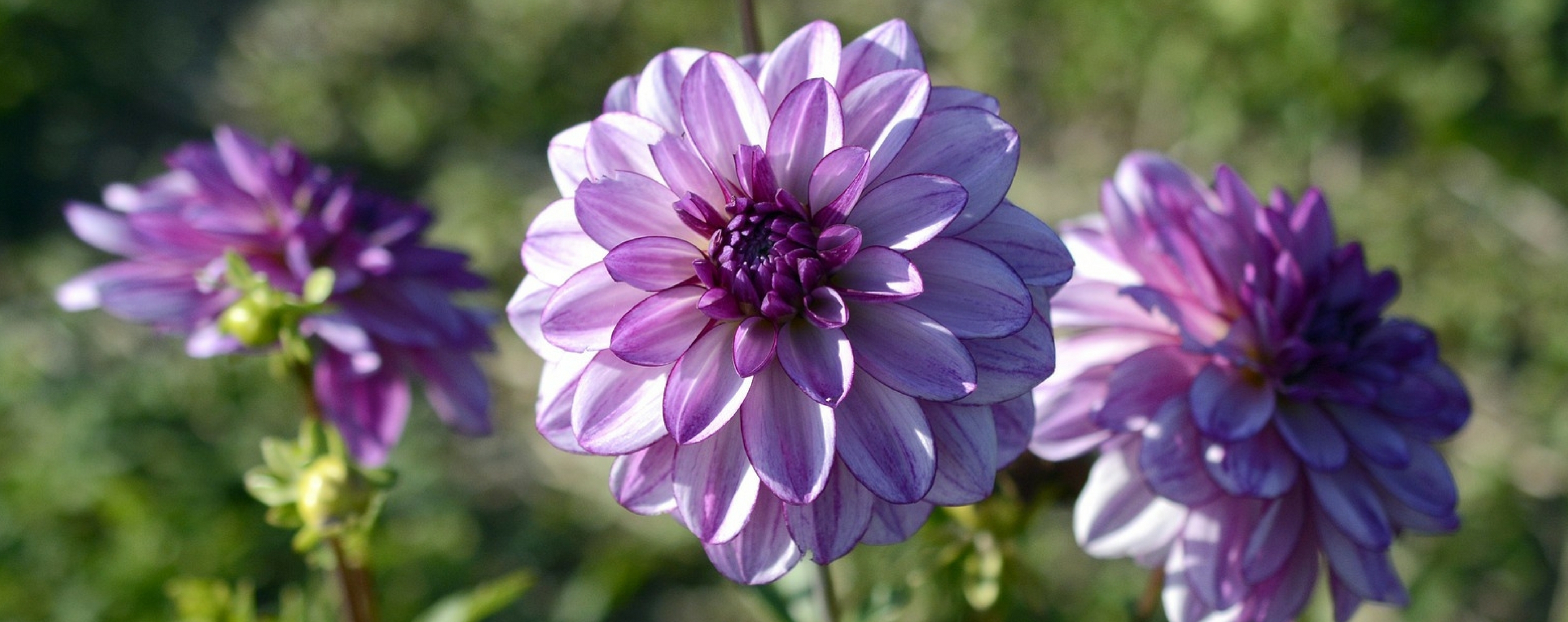
Dahlia: planting, care, and growing tips
Contents
Dahlia in a nutshell
- The dahlia flowers abundantly and for a long time. Its uninterrupted flowering begins in summer and ends at the onset of winter.
- Its flowers, described as camellia, anemone, cactus, pompon, or peony, come in an infinite variety of shapes and colours.
- Ranging from giants reaching up to 2 m to dwarfs not exceeding 60 cm in height, there are hundreds of varieties of dahlias suited to all gardens.
- Not very hardy in most regions, its tubercles need to be lifted to be stored away from frost during winter.
- It is an essential flower in cottage gardens, vibrant exotic beds, vegetable plots, mixed borders, window boxes, and summer cut flower arrangements.
A word from our expert
With its beautiful vintage or highly graphic appearance and its infinitely variable colours, the Dahlia has made a remarkable comeback in recent years, once again gracing naturalistic gardens as well as vegetable gardens, unicoloured or multicoloured summer flower beds like mixed-borders and window boxes, adding a romantic, whimsical, or exotic touch.
Classic or extravagant, sophisticated or simple, subtle or exuberant, miniature or giant, this summer-flowering bulb belongs to a very large family with varied shapes, colours, and sizes, offering a limitless choice for gardeners. Having Dahlias in the garden promises a summer full of colour! Why deprive yourself?
Their simple or very double flowers in anemone, cactus, or pompon forms come in a myriad of tones, from vibrant to pastel. Orange with bronze highlights, coppery pink or apricot magenta pink, straw yellow, crimson red, virginal white, lilac blue, or even indigo violet, they bloom all summer and into the autumn, from July to October without interruption, creating fresh, colourful, and original bouquets.
Whether it’s a “Pom-Pom Dahlia“, “Giant Dahlia“, or “Dwarf Dahlia“, “Dahlia for flower beds“, “Decorative Dahlia“, “Collarette Dahlia“, “Cactus Dahlia” or “Semi-Cactus Dahlia”, “Landscape Dahlia“, you will surely find the Dahlia that pleases you among the more than 200 varieties of Dahlias online, some of which are exclusive to us in the most beautiful sizes available.
Dare to invite them into your garden to create vibrant and luminous scenes!
Botany and description
“`html
Botanical data
- Latin name Dahlia
- Family Asteraceae
- Common name Dahlia
- Flowering From July to November
- Height 0.15 to 2 m
- Exposure Sun
- Soil type Neutral
- Hardiness Semi-hardy (not below -5°C) sensitive to frost
Originating from the high plateaus of Mexico and Central America, the Dahlia belongs to the large family of Asteraceae, which includes daisies, asters, and echinaceas. There are 30 species and nearly tens of thousands of cultivars: today, nearly 20,000 horticultural varieties are found all over the world. Most are derived from Dahlia pinnata and D. coccinea. Discovered in the 16th century, the Dahlia was only introduced to Europe two centuries later. The Dahlia imperialis, the botanical species that bore simple flowers, was then very different from the modern Dahlia.
From its origins in the dry Mexican environments, it has retained its fondness for warmth and sunlight but has a congenital sensitivity to cold! Moderately hardy, the Dahlia is very sensitive to cold; its tubers must be wintered in most of our regions as it fears frost. It cannot withstand temperatures that drop persistently and often below -5°C. However, if stored all winter well protected from frost, it will bloom again for many years.
Today, the Dahlia has become popular throughout France, found in all summer flower beds. There are two main types: large-flowered tuberous Dahlias and dwarf Dahlias that are easily propagated by sowing. Among the most appreciated and widespread are the Dahlias with anemone flowers, with orchid flowers, collarette Dahlias, decorative Dahlias, pompon and ball Dahlias, cactus and semi-cactus Dahlias, giant Dahlias, and dwarf Dahlias, both single and double.

The shape of Dahlia flowers varies by variety: ball, water lily, or cactus…
The Dahlia is part of a vast family with very varied shapes, colours, and heights. The tallest specimens easily reach 1.50 m high, and even more in fertile soil, with a spread of 45 to 80 cm. Among them is Dahlia Imperialis, the botanical ancestor of the Dahlias in our gardens, which can reach up to 3 m in height. Intermediate Dahlias grow between 80 cm and 1.10 m. Dwarf varieties, ranging from 0.25 to 0.70 cm, do not require staking.
This perennial has swollen, tuberous roots, gathered in bundles, resembling small potatoes. Edible, they were initially cultivated for consumption. However, their rather tasteless roots were soon neglected in favour of the plant’s exceptional flowering.
From its bushy, upright base emerge rigid, tubular, erect, hollow, and ramified stems bearing inflorescences from July to October (until November in temperate climates) that renew themselves throughout the summer without interruption.
The Dahlia flower has a strong character, an assertive personality so pronounced that it stands out among thousands. Its solitary head inflorescences are formed of one or more rows of radiant ligules surrounding a central disc of more or less apparent pistils, depending on the variety. The diameter of the flowers ranges from 10 cm to 25 cm or even more! They are classified according to the size of their inflorescences:
- Giant: over 25 cm in diameter (Giant Dahlias)
- Large: 20 to 25 cm in diameter (Cactus Dahlias, Ball Dahlias)
- Medium: 15 to 25 cm in diameter (Water Lily Dahlias)
- Small: 10 to 15 cm in diameter (Anemone Dahlias, Collarette Dahlias, Decorative Dahlias)
- Miniatures: less than 10 cm in diameter (Pompon Dahlias)

Giant Dahlia ‘Emory Paul’-‘Mel’s Orange Marmalade’-‘Burlesca’
Giant Dahlias, such as Dahlia ‘Emory Paul’, bear enormous flowers that can reach up to 35 cm in diameter, the size of a plate.
Another variable of the Dahlia is the shape of its flower, which establishes a classification. These ligulate, unscented flowers can be simple, semi-double, or very double. The shape of the ligules varies by cultivar: curled, flat, lace-like…
The Decorative Dahlias do not have a central disc but large, double flowers with generally flat, rounded petals that are slightly curved, sometimes resembling a water lily or a camellia . The elegant semi-cactus or Cactus Dahlias bear long, pointed, curled petals that form a pom-pom-like heart resembling a cactus flower, as seen in the Dahlia Mel’s Orange Marmalade. In this group, the narrow, very elongated ligules of the head curl over more than half their length. The lace cactus is characterized by large, cut flowers with pointed, flat, or curled petals ending in forked tips, reminiscent of lace.
Others, formed by a crown of wider ligules surrounding a very double heart of smaller florets, resemble an anemone. Some Dahlias have long, incurved or turned ligules arranged in a star shape, reminiscent of an orchid.
The collarette Dahlias or simple flowers only have a single crown of petals around a central disc surrounded by an inner collar of shorter ligules (the heart and tips often offer a striking contrast, as seen in the Dahlias ‘Pooh’ or ‘Fashion Monger‘).
Imbued with whimsy, the Honka Dahlias bear star-shaped flowers, with fine, very curled petals detached from one another around an orange centre, making them resemble delicate windmills or curious spiders.
In contrast, we find the pompon Dahlias, very graphic, whose tubular ligules form a spherical inflorescence of about 10 cm for the largest, sometimes flattened at the top, presenting an alveolate structure, similar to a beehive, as seen in the Dahlia ‘Burlesca’. The ball Dahlias bear flowers similar to pompon Dahlias, but larger, with a diameter that can reach 12 cm.
The flowering of the Dahlia is of incredible colour richness: its flowers come in an infinite palette of colours ranging from light pink to lilac pink, from wine to crimson red, from apricot to carmine salmon, from pure white to café au lait or primrose yellow, from indigo violet to lilac blue (‘Worton Blue Streak’ is currently the bluest cactus!).
Very good in a vase, Dahlia heads make wonderful summer bouquets rich in colour. Some varieties, such as Dahlia ‘Karma Lagoon’, have been specially developed for cut flowers.
Deciduous, the abundant foliage adds a certain lushness and highlights the exotic colours and voluptuous shapes of the flowers. The opposite leaves, finely dentate, range from 20 to 50 cm long, are either pinnate or very rounded and divide into three to five leaflets, more or less leathery. The colour of the foliage also allows for beautiful variations, ranging from light green to emerald green or bronze green, or even purplish (Decorative Dahlia ‘Purple Flame’, Happy Single ‘Juliet’, Dahlia Happy Single ‘Flame’) depending on the different types.

Dahlia ‘Pooh’ – ‘Happy Single Juliet’ – Honka ‘Pink’- ‘Fashion Monger’
Contrary to popular belief, the Dahlia is not difficult to grow, but it does require some attention. It will only be happy and floriferous in a warm and sunny situation. While it adapts to all soils, it thrives in fertile soil, rich in humus, fresh, and well-drained, preferably neutral, neither acidic nor calcareous. It likes light soils that remain fresh and kept sufficiently moist with good mulch during the growing season. The Dahlia does not tolerate standing water, especially in spring and autumn. A cool soil allows it to develop vigorously. It requires, to bloom well, a soil rich in organic matter. It will never be lush and will struggle in poor, sandy soil. Large Dahlias are quite susceptible to wind or heavy rain. If you want to avoid unsightly staking, it is better to give them a place sheltered from prevailing winds that could cause the stems to bend.

Dahlia ‘Ridel’ and Hordeum jubatum (foxtail barley) – credit-Noun – MAP
An essential in church gardens, the Dahlia is a versatile flower that brings colour, relief, and originality to flower beds, rockeries, borders, and flowering pots as well as to the vegetable garden. The Dahlia can be grown alone, but is preferably planted in groups, in the middle or back of a sunny bed, associated with grasses and other vigorous perennials that will act as supports, preventing their flowering stems from lying down unsightly. Dwarf varieties are reserved for borders or window boxes. Magnificent in beds, decorative Dahlias make excellent cut flowers for bright and colourful summer bouquets.
This plant was named “dahlia” in honour of the Swedish botanist Andreas Dahl.
“`
Main species and varieties
There are 30 species and nearly tens of thousands of Dahlia hybrids: today, nearly 20,000 horticultural varieties are found all over the world. Most are derived from Dahlia pinnata and D. coccinea. Discover our vibrant collection of dahlias, varied in flower shape and the infinite palette of their colours. They are classified according to the shape and diameter of their flowers, ranging from dwarf to giant. From the most classic to the most surprising, whether it’s a “ball” dahlia, “giant”, “dwarf”, “border”, “collarette”, “decorative”, “cactus” or “semi-cactus”, “Honka”, “orchid flower” or anemone or camellia, you will surely find the dahlia that suits you among the more than 200 varieties, some of which are exclusive to us, in the most beautiful sizes available. Dare to mix, match, and blend them; you will brighten up your rockeries, borders, flowering pots, and mixed borders for several months on end!
They are characterised by large flowers formed of a crown of flat petals surrounding a very double heart of smaller florets. Their unique colours, sometimes contrasting, inevitably attract all eyes. You will find subjects of beautiful stature to integrate into perennial borders, as well as dwarf varieties, ideal for pots or for creating lovely summer bouquets.

Dahlia Blue Bayou
- Flowering time August to November
- Height at maturity 1 m
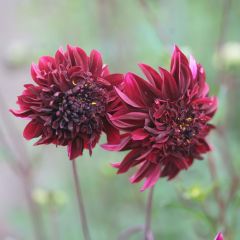
Dahlia Anemone Soulman
- Flowering time August to November
- Height at maturity 70 cm
This is a horticultural category defined by the shape of the flower that… resembles a cactus flower! They bear very large double flowers measuring 12 to 20 cm, with a beautifully tousled appearance and petals that are elongated and pointed, completely rolled. Semi-cactus dahlias have similar flowers but with narrower ligules that are less long and partially rolled. The taller varieties will provide a surprising focal point at the back of a border. Dwarf cactus dahlias, not exceeding 60 cm in height, are perfect for borders or the foreground of a border.
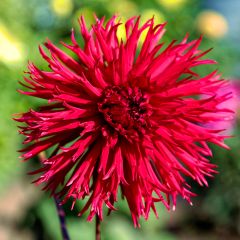
Dahlia Urchin
- Flowering time August to November
- Height at maturity 1 m
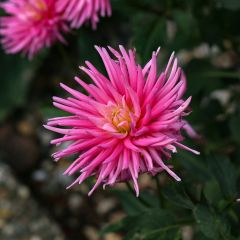
Dahlia Blue Record
- Flowering time August to November
- Height at maturity 60 cm
In this group, the flowers are simple adorned with a tousled and contrasting heart. The wide, flat ligules of the head are arranged regularly in a crown around a collar of small short petals that reveal a yellow heart. The collar, often a different colour, offers a surprising contrast. The dwarf varieties, not exceeding 40 cm in height, are simply sensational in flowering borders and pots.
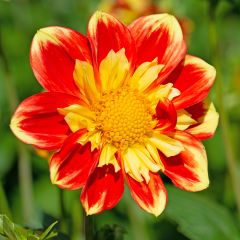
Dahlia 'Pooh'
- Flowering time August to December
- Height at maturity 1,20 m
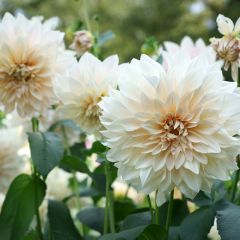
Dahlia Café au Lait
- Flowering time August to November
- Height at maturity 1,20 m
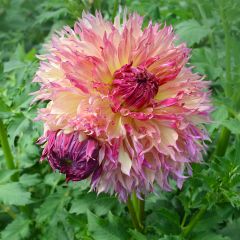
Dahlia Myrtle's Folly
- Flowering time August to November
- Height at maturity 1,20 m
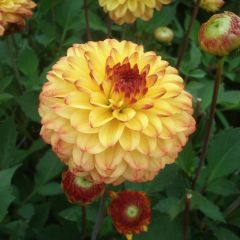
Dahlia Icoon
- Flowering time August to November
- Height at maturity 1 m
Discover other Dahlias
View all →Available in 1 sizes
Available in 1 sizes
Available in 0 sizes
Available in 1 sizes
Available in 1 sizes
Available in 1 sizes
Available in 0 sizes
Available in 0 sizes
Available in 1 sizes
Available in 1 sizes
Planting Dahlias
When to plant?
With Dahlias, there’s no need to rush; they must be planted on time: if planted too early, the first shoots may be devoured by slugs. The tubers stored safely over winter should be planted in spring, in March after the last frosts. In colder regions, wait until late April or early May, as soon as the soil is warmed and can be worked. Simply store the purchased tubers in a frost-free place until the right planting time.
Where to plant?
Dahlias grow almost everywhere in France. The essential condition for flourishing dahlias is to plant them in full sun. The second requirement: ensure they have well-drained soil where water does not stagnate, especially in spring and autumn. Dahlias prefer light soils that remain cool and sufficiently moist with a good mulch during the growing season. Stagnant moisture, however, would encourage tuber rot.
While they can thrive in any soil that is not too acidic or calcareous, they flourish in good fertile garden soil, rich in humus, cool, well-drained, and preferably neutral. Dahlias are greedy: to bloom well and gain vigour, they need a good base fertilisation. If you’re unsure about the soil’s nutritional qualities, fertilise (with compost or manure) in autumn.
 Dahlias can be planted in borders as well as in the vegetable garden
Dahlias can be planted in borders as well as in the vegetable garden
Large Dahlias do not withstand strong winds or heavy rain well. A windy location could dry out the foliage and especially cause the stems to bend. It’s better to reserve a sheltered spot away from prevailing winds. For tall Dahlias, staking may be essential to support the heads, preventing the stems from breaking at the slightest gust, especially if they are planted in isolation. To prevent their flower stems from collapsing in the middle of a border, it is also advisable to plant Dahlias alongside other plants and bushes for support.
When planting, allow enough space for them in your border composition. Ensure each plant remains easily accessible for fertilising, staking, pinching, and wintering.
While they fit into all garden settings, both in the garden and vegetable patch, Dahlias truly shine as background or mid-border plants, adding a vibrant splash of colour.
Dwarf varieties are better suited for sunny flower beds, path edges, or pot cultivation on a sunny terrace or balcony. Potted plants should be planted in good potting soil and need to be watered very regularly and receive a good bulb-specific fertiliser.
How to plant?
Dahlias are very demanding. To meet their nutritional requirements, it is best to loosen the soil in autumn with a base fertilisation or just a few days before planting. If your soil is too heavy, add potting soil and gravel to areas where water tends to stagnate.
Planting the tubers
Around mid-April, as soon as the soil can be worked deeply, plant your dahlias.
- Space large dahlias 80 to 100 cm apart.
- Space small varieties 30 to 50 cm apart.
- Work the soil to a width and depth of 20 cm, mixing in a handful of roasted horn powder or dehydrated blood with your well-crumbled garden soil. Dahlias are greedy: they need a good base fertilisation.
- Position the tubers so that the collar is 5 cm below the soil level.
- Cover them with about 10 cm of soil.
- Place stakes for the taller varieties, being careful not to damage the tubers; this will also help you locate where you buried your dahlias!
- Water thoroughly and then regularly for the first six weeks to aid rooting.
- Scatter some slug pellets at the base of the planted tubers to help the first shoots emerge.
- Then mulch the soil once the plants are established.
→ Read also: Planting Dahlias: 8 common mistakes to avoid and How to force Dahlias to flower earlier?
Read also
The best Dahlias for bouquetsWintering of dahlia tubercles
Dahlias are extremely frost-sensitive and fear frost. In regions with harsh winters where temperatures regularly drop below -5 °C, lifting is obligatory if you want to keep them alive. In regions with mild winters where frosts are light and infrequent, and in well-draining sandy soil, the tubercles can remain in place for the winter simply protected by a good mulch of dry leaves or straw. Lifting allows for dividing the tubercles and potting them for earlier flowering.
At the end of October to early November (not before, as the roots would not have sufficient reserves for winter), when the plant weakens and the first frosts begin to blacken the leaves, it is time to dig up the tuberous stumps. The goal is simple: to protect them from frost!
- As soon as the foliage is blackened by frost, cut the stems to 15 cm above the ground.
- Gently dig up the tubercles using a fork.
- Remove as much soil as possible from between the tubercles.
- Label each stump at the base of the stem so you can easily recognise the plants in spring.
- Place the bulbs on a layer of turf, dry sand, or dry leaves in a cardboard box or a deep crate.
- Cover the tubercles with a layer of turf or dry leaves.
- Store them away from light, draughts, rodents, and… especially frost in a dry, cool, well-ventilated, and dark place where the temperature should not exceed 4 to 5 °C (dry cellar, garage, or frost-free attic). Under these perfect conditions, dahlias keep very well, with almost no risk of loss.
- Regularly check the condition of the plants to detect any diseases.
→ Read also: How to overwinter dahlias to protect them from frost?, How to store bulbs properly?, and Overwintering Dahlias: should you lift them?
Maintenance and care
Dahlia is relatively easy to grow, but requires some attention. A few simple actions will ensure you have a flowering summer.
- In spring, protect young shoots from slugs.
- During the growing season, Dahlia is thirsty. Water generously during the growth of the buds.
- In July, mulch with a 2 cm layer of dry straw or turf to retain moisture throughout the summer. Water the mulch.
- Support the stems of larger plants if necessary as the plant develops.
- Tie up the young stems.
- 2 to 3 weeks after planting, pinch the terminal shoot to encourage branching and increase flowering, especially if the tubers produce only a single stem. This will spread the plant’s habit, offering more resistance to the elements and possibly eliminating the need for unsightly staking.
- To achieve larger flowers, pinch off the side buds afterwards.
- Remove small shoots in the axil of the leaves: the heads will be larger as a result.
- Remove faded flowers to encourage the appearance of new blooms and extend the flowering period.
- Water very regularly, and twice a week during hot weather, at the base of the plant and not on the foliage.
- At the end of summer, apply organic fertiliser to promote growth.
- In autumn, incorporate a good amount of manure or well-matured compost into the garden soil.
Pests and diseases
Dahlia is wary of slug attacks which, in spring, will devour its young shoots; fern manure or wood ash will deter them. Later in the season, aphids may attack the young stems bearing buds: combat them with diluted black soap. Earwigs love tender petals, but their voracity does not harm the plant’s health. The plant may show signs of deficiency (thin stems, yellow leaves, small size) due to a lack of nutrients; apply a compost mulch and a complete fertiliser. Grey rot can affect the tubers in cases of excessive moisture.
→ Learn more about dahlia diseases and pests in our article!
Multiplication
Propagation by cuttings
This is the best way to obtain a large number of plants, but it is quite tedious; we recommend dividing your tubercles instead. Propagation by cuttings is done with tubercles that have been pre-sprouted. At the beginning of March, take the roots that have been stored over winter and place them in a new mixture of compost or moist turf. Three weeks will be needed to see shoots appear. Cuttings will be taken when these shoots are about ten centimetres long. Potted under a cold frame and then repotted, they can be planted in the open ground by early June.
Propagation by division of tubers
This is the simplest method. It can be done just before planting.
- In spring, at the end of March, take the roots that have been stored over winter.
- Divide the tubercles into two or three fragments with a sharp knife or pruning shear, ensuring that each piece has a part of the old stem with an eye, from which the new shoots will emerge.
- Cover the wounds with charcoal.
- Only plant in mid-April to early May if small buds have appeared; otherwise, wait and water to encourage their emergence.
Discover our video tutorial on dividing dahlias:
To learn more, check out our tutorial: Multiplying Dahlias: the right techniques. Also read: How to sow Dahlias ?
Pairing ideas
Incontournable des jardins de curé, le Dahlia est un florifère polyvalent qui apporte couleur, relief et originalité aux massifs, rocailles, plates-bande, potées fleuries aussi bien qu’au jardin potager. Le Dahlia se cultive en isolé mais se plante de préférence en groupe en milieu ou en arrière-plan de massif ensoleillé, associé à des graminées (Panicum, Molinia, Calamagrostis), à d’autres vivaces à fort développement (Cosmos, Asters, Echinacées, Cannas) qui joueront les souteneurs, empêchant leurs hampes fleuries de se coucher de façon disgracieuse.

Dahlias ‘Purple Flame’- Calamagrostis – Asters – Echinacées-
Les Paysages, les Mini-balles ou les Honkas aux pétales pointus composeront des scènes légères. On réserve les Gallery et les variétés naines Happy Single ou les Dahlias collerette (‘Impression Fantastico‘ aux bordures ou aux jardinières. Magnifiques en massif, les Dahlias décoratifs, feront d’excellentes fleurs coupées pour des bouquets d’été lumineux et colorés.
Envie d’un peu plus d’inspiration ? Découvrez notre fiche conseil : “Dahlias, bien les associer au jardin”
Useful resources
- The most beautiful collection of dahlias is with us; Our new gladiolus and dahlias for spring 2022; Our new dahlias for spring 2023
- All the new dahlias are on our site!
- 3 atmospheres with dahlias, to discover on our blog
- Don’t miss the planting of your dahlias, follow our advice!
- How to divide your dahlias? All the tips in our advice sheet
- Discover how to winter your dahlias with our video tutorial
- Should you dig up dahlias? Answers with Ingrid on our blog
- Indigo violet, mahogany or pale pink, with Sophie, discover the full range of dahlia colours on our blog
- See dahlias at the Floral Park of Paris, officially recognised as a botanical garden since 1998, which features several hundred varieties of dahlias!
- Discover our 7 pairing ideas to create beautiful summer planters
- Find out how to grow a dahlia in a pot
- Discover the best ball dahlias
- Learn how to pinch dahlias to get more flowers
- Discover 5 giant dahlias to plant at the back of a border
- Find our tips for growing dahlias in hot weather
- We present 5 dahlias for border planting
- A bouquet of dahlias for £1, is it possible? Find out in our article!
- Subscribe!
- Contents































